The deep ocean’s eternal darkness conceals an extraordinary phenomenon—bioluminescence, the biological production of light. In these lightless depths, where sunlight cannot penetrate, many creatures have evolved the remarkable ability to generate their own illumination. This captivating adaptation serves various purposes: attracting prey, confusing predators, communicating with potential mates, or simply lighting the way through the abyssal plains. Below the ocean’s surface, nature has crafted living light shows more spectacular than any human-made display. Let’s dive into the mysterious world of 16 remarkable deep-sea creatures that bring light to the darkest place on Earth.

Perhaps the most iconic of all bioluminescent creatures, the female anglerfish sports a modified dorsal spine that dangles above its head like a fishing rod, complete with a glowing lure at the end. This bioluminescent organ, called an esca, contains light-producing bacteria that live symbiotically with the fish. When smaller fish are attracted to this hypnotic light in the darkness, the anglerfish strikes with lightning speed, engulfing prey in its disproportionately large jaws lined with needle-like teeth. What makes this relationship particularly fascinating is that the anglerfish cannot produce light on its own—it depends entirely on these bacterial partners that it houses in specialized organs. Some species of anglerfish live at depths exceeding 3,000 meters (9,800 feet), where their bizarre appearance and predatory strategy have evolved perfectly for the extreme pressure and perpetual darkness.
Vampire Squid Glowing Arm Tips and Light Organs

Despite its intimidating name, the Vampire Squid (Vampyroteuthis infernalis, which translates to “vampire squid from hell”) is neither a true squid nor a true octopus but belongs to its own separate order. This ancient living fossil possesses light-producing organs called photophores at the tips of its arms and scattered across its body. When threatened, the vampire squid can activate these photophores in a dazzling display called a “light show,” creating confusion for predators. Even more remarkably, it can eject a cloud of bioluminescent mucus instead of the typical ink used by its relatives, effectively creating a glowing cloud that distracts predators while it escapes. Living at depths between 600 and 1,200 meters (2,000-4,000 feet), this creature has adapted to oxygen-minimum zones where few predators venture, making it a true specialist of the deep ocean’s most challenging environments.
Atolla Jellyfish The Burglar Alarm
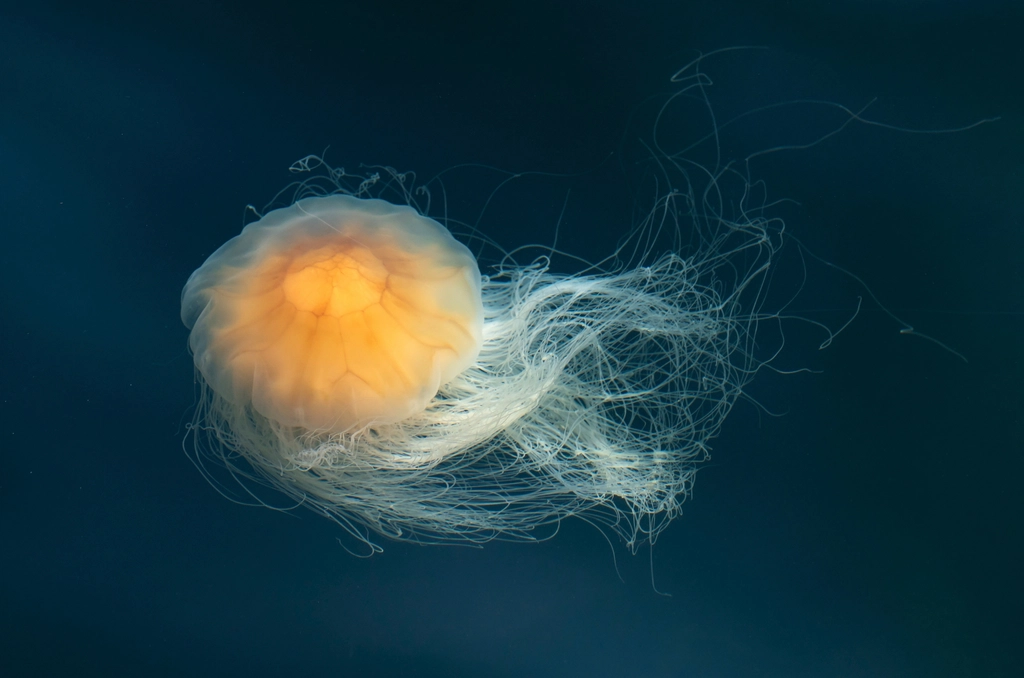
The Atolla jellyfish, sometimes called the Coronate medusa, employs one of the most sophisticated defense mechanisms in the deep sea, aptly nicknamed the “burglar alarm.” When attacked by a predator, this jellyfish produces an intense series of circular light pulses that ripple outward from its bell in brilliant blue waves. However, this isn’t an attempt to scare off its attacker—rather, it’s calling for backup. The light display attracts larger predators in the vicinity that might prey upon the Atolla’s attacker, giving the jellyfish a chance to escape during the ensuing confusion. This strategic use of bioluminescence demonstrates remarkable evolutionary sophistication. The Atolla jellyfish typically lives at depths between 500 and 4,000 meters (1,600-13,000 feet) and has a distinctive crown-like appearance with one tentacle significantly longer than the others, which it uses to snare prey as it drifts through the water.
Lanternfish The Ocean’s Nightlights

Lanternfish (family Myctophidae) are among the most abundant vertebrates on the planet, making up an estimated 65% of all deep-sea fish biomass. These small fish—typically measuring only 3 to 15 centimeters (1-6 inches)—possess rows of photophores along their ventral (bottom) surface that emit a bluish-green light. This patterned arrangement of light organs is often species-specific, functioning like a biological barcode that helps lanternfish identify potential mates in the darkness. Lanternfish engage in one of the ocean’s most spectacular daily migrations, traveling from depths of up to 1,000 meters (3,300 feet) during the day to surface waters at night to feed on plankton, before returning to the safety of the deep before dawn. This vertical migration represents the largest daily movement of biomass on Earth and plays a crucial role in carbon sequestration in the ocean, making these tiny glowing fish surprisingly important for global climate regulation.
Viperfish Illuminated Fangs and Predatory Tactics

The viperfish (Chauliodus spp.) combines terrifying appearance with bioluminescent hunting strategies. Its most distinctive features are its enormous fang-like teeth, so large they cannot fit inside the mouth and instead curve back toward the eyes. Along its dorsal spine and across its body, the viperfish has photophores that produce greenish light. Particularly fascinating is how some species can illuminate their fangs, using the light reflection to attract curious prey close enough to strike. With one of the fastest strikes recorded in fish, the viperfish can snatch prey in approximately 1/50th of a second. Growing up to 60 centimeters (2 feet) in length, these formidable predators live at depths between 200 and 5,000 meters (650-16,400 feet). Despite their fearsome reputation, viperfish typically live only 30-40 years in the wild, and their specialized hunting adaptations make them nearly impossible to keep in captivity, with no successful long-term aquarium specimens recorded.
Hatchetfish Masters of Counter-Illumination

Deep-sea hatchetfish (family Sternoptychidae) have perfected a sophisticated form of camouflage called counter-illumination. These small, silvery fish have downward-facing photophores along their bellies that emit light matching the faint sunlight filtering down from above. This ingenious adaptation helps eliminate their silhouette when viewed from below by predators. The intensity of their bioluminescence can be adjusted to match changing light conditions as they move through different depths, functioning essentially as biological dimmer switches. Their distinctive body shape—laterally compressed and resembling the blade of a hatchet—gives them their common name and provides stability in the water column. Most species are small, typically 2.5 to 10 centimeters (1-4 inches) in length, and live at depths between 200 and 600 meters (650-2,000 feet) in tropical and temperate oceans worldwide, where they feed primarily on small crustaceans and other planktonic organisms.
Dragonfish Red Light Special
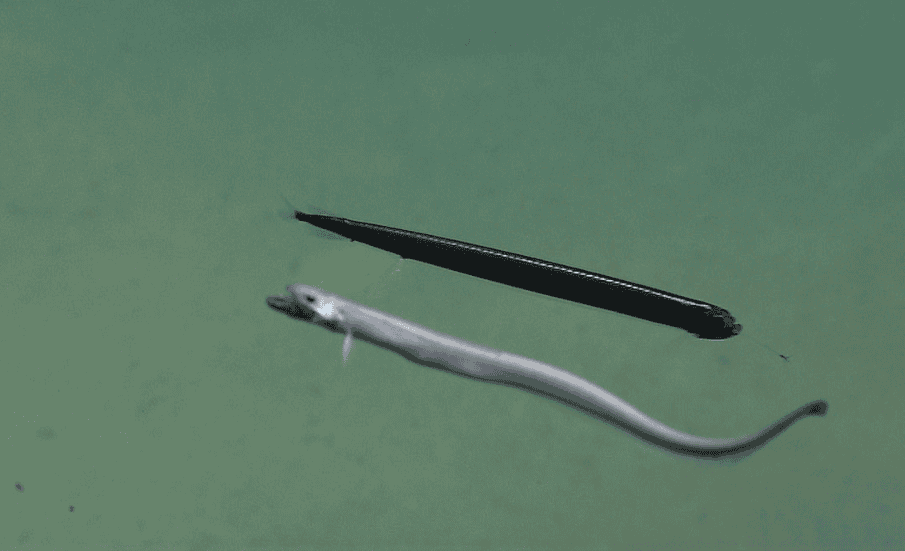
The loosejaw dragonfish (genus Malacosteus) possesses one of the most specialized bioluminescent systems in the ocean. Unlike most deep-sea creatures that produce blue or green light (the colors that travel farthest underwater), these fish can generate red bioluminescence—a near-superpower in the deep sea. Most deep-sea creatures have evolved to see only blue light since other wavelengths don’t penetrate these depths, making them essentially blind to red light. The dragonfish exploits this by using red bioluminescence as a kind of “private” searchlight to hunt prey that cannot see the illumination. This rare ability comes from a unique light-producing compound called dragonfish chlorophyll, derived from consuming certain crustaceans and modified within specialized light organs. Growing to about 25 centimeters (10 inches) in length, these remarkable predators live at depths between 500 and 2,000 meters (1,600-6,500 feet) and have extremely distensible jaws and stomachs, allowing them to consume prey larger than themselves.
Firefly Squid Synchronized Light Displays

Japan’s Firefly Squid (Watasenia scintillans) creates one of the ocean’s most spectacular light shows. These small cephalopods—reaching only 7.5 centimeters (3 inches) in length—possess approximately 5,500 photophores distributed across their bodies, with dense concentrations at their tentacle tips. What makes them truly remarkable is their ability to control each photophore independently, producing complex patterns of blue light that ripple across their bodies. During breeding season in Japan’s Toyama Bay, millions of these squid rise to the surface to spawn, creating a breathtaking natural spectacle that draws tourists from around the world. The bioluminescent displays serve multiple purposes: attracting mates, confusing predators, and illuminating prey. Unlike many deep-sea creatures, firefly squid undergo daily vertical migrations, spending daylight hours at depths of about 400 meters (1,300 feet) and rising toward the surface at night to feed on small fish and crustaceans.
Cookie-cutter Shark Glowing Guerrilla Hunter
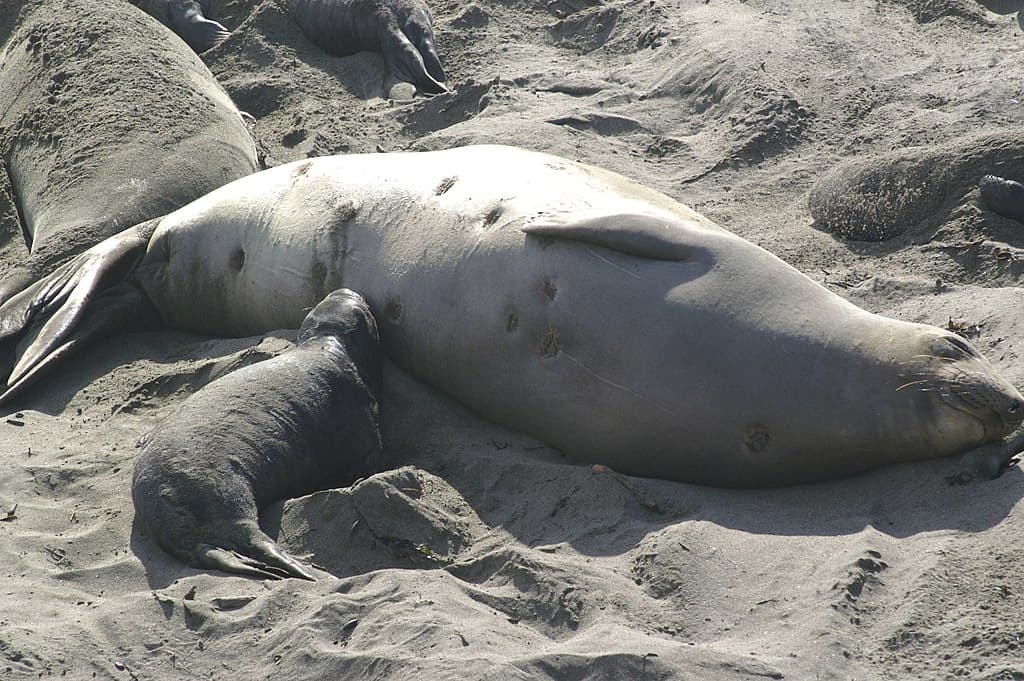
The cookie-cutter shark (Isistius brasiliensis) employs one of the most devious hunting strategies in the animal kingdom, using bioluminescence as part of its ambush technique. This small shark—typically just 42-56 centimeters (16-22 inches) long—has photophores covering its belly but possesses a conspicuous non-luminous patch under its throat. When viewed from below against the faint light from the surface, this dark patch appears as a small fish, while the glowing body blends with the downwelling light. When larger predators approach what they perceive as an easy meal, the cookie-cutter strikes, using its specialized jaw and teeth to extract a perfectly circular plug of flesh before quickly retreating. The resulting wounds look as if made by a cookie-cutter (hence the name). These remarkable parasitic predators have been known to take bites from tuna, dolphins, whales, and even submarines and underwater cables. They typically inhabit tropical and oceanic waters at depths between 85 and 3,500 meters (280-11,500 feet) and undergo vertical migrations, rising toward the surface at night to hunt.
Comb Jellies Rainbow Light Displays

Comb jellies, or ctenophores, produce some of the most visually stunning bioluminescent displays in the ocean, though through a different mechanism than true bioluminescence. While they can produce blue-green light when disturbed (true bioluminescence), their more famous rainbow effect comes from light diffraction. These gelatinous organisms possess rows of cilia (tiny hair-like structures) called “combs” that beat in coordination for locomotion. As light hits these moving combs, it diffracts into a spectacular rainbow pattern that ripples along their transparent bodies. The deep-sea species Bathocyroe fosteri exemplifies true bioluminescence, producing a blue-green glow when disturbed as a defense mechanism. Despite their jellyfish-like appearance, comb jellies belong to an entirely different phylum and are among the oldest animal groups on Earth, with some scientists suggesting they may have been the first branch to split from the animal family tree. These delicate creatures typically range from 1 to 10 centimeters (0.4-4 inches) in size and are found at various depths, with deep-sea species often displaying the most vivid bioluminescence.
Tomopteris Glowing Ocean Worms
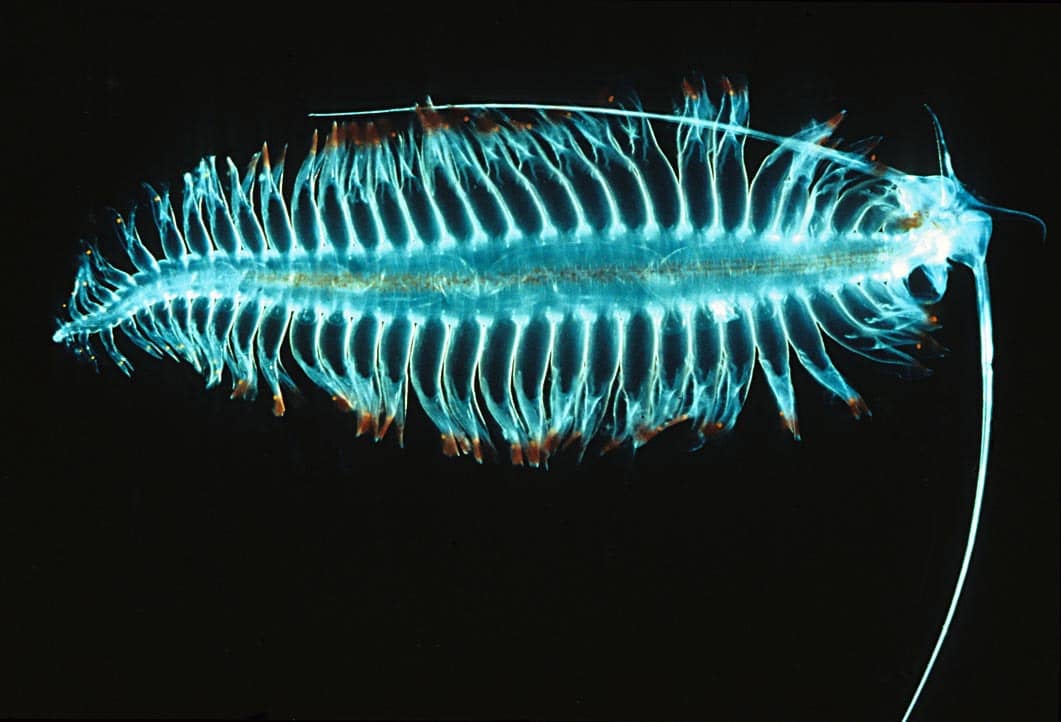
Tomopteris worms represent one of the rare examples of yellow bioluminescence in the ocean. These transparent swimming polychaete worms emit a golden-yellow light from specialized cells in their paddle-like parapodia (swimming appendages), making them look like glowing underwater centipedes. What makes their bioluminescence particularly unusual is that most marine organisms produce blue or green light, as these wavelengths travel furthest in water. The biochemical mechanism behind their yellow bioluminescence remains poorly understood but appears to involve unique light-emitting compounds. Growing to about 10 centimeters (4 inches) in length, these active predators hunt small crustaceans and other zooplankton in the mesopelagic zone (200-1,000 meters/650-3,300 feet deep). Research suggests they may use their bioluminescence primarily as a defense mechanism, creating bright bursts when attacked that either startle predators or attract secondary predators to create confusion—a strategy similar to the “burglar alarm” of the Atolla jellyfish.
Bioluminescent Bamboo Coral Living Light Towers
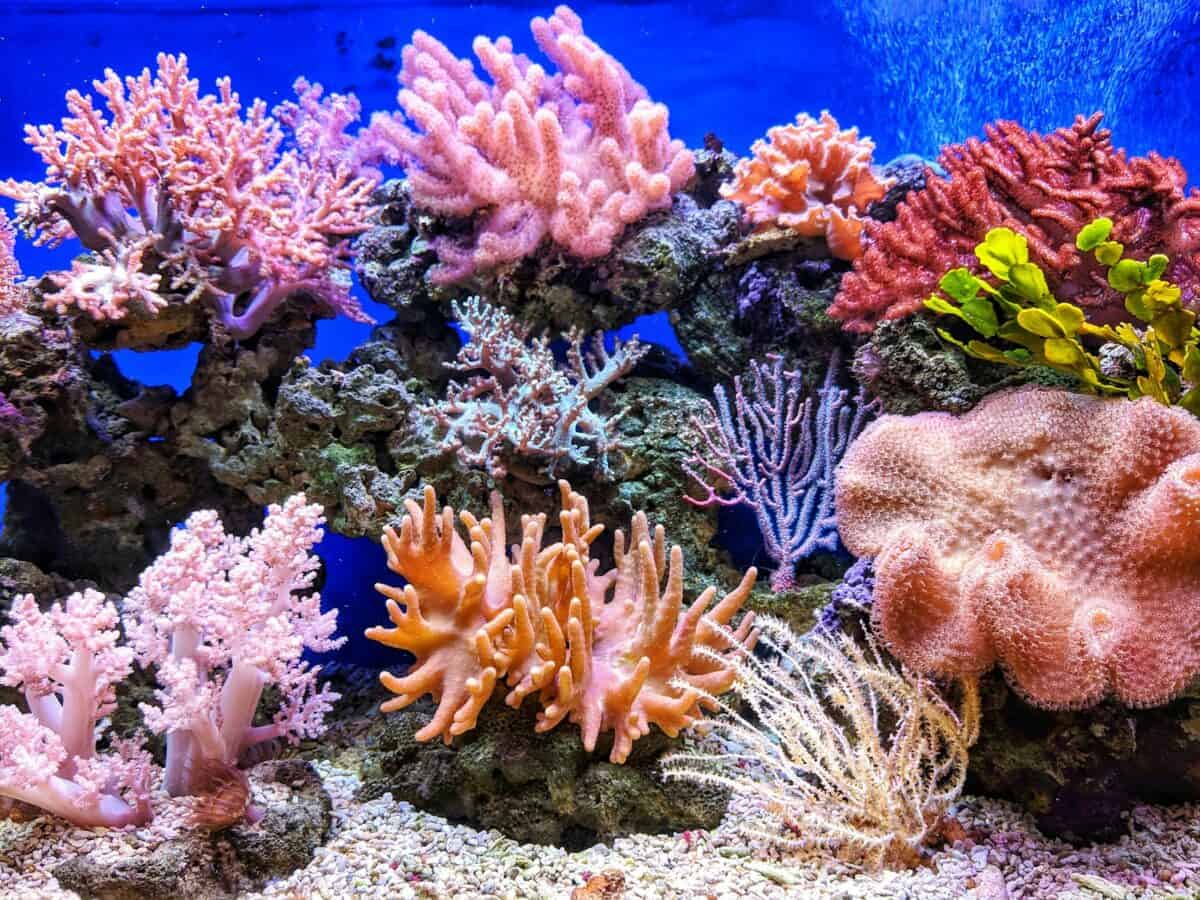
Unlike many mobile deep-sea creatures that use bioluminescence for hunting or defense, bamboo corals (family Isididae) represent sessile organisms that create their own light. These beautiful colonial animals can grow several meters tall and live for centuries, creating important three-dimensional habitats in the deep sea. Their bioluminescence appears as a gentle blue-green glow that travels in waves across the colony when disturbed, creating an ethereal effect sometimes described as “communicating with light.” Scientists believe this luminescence serves primarily as a defense mechanism, potentially startling predators or attracting larger animals that might prey on whatever is disturbing the coral. Found at depths between 400 and 3,000 meters (1,300-9,800 feet), these corals grow in a distinctive pattern of calcified nodes separated by protein-rich internodes that resemble bamboo segments. Their slow growth rate—sometimes less than a millimeter per year—makes them particularly vulnerable to damage from deep-sea trawling and other human activities, prompting conservation concerns.
Brittle Stars Five Arms of Light

Certain species of brittle stars, particularly Ophiopsila californica, have mastered the art of bioluminescence among echinoderms. These relatives of starfish possess five long, serpentine arms radiating from a central disc, with specialized light-producing cells distributed along their arms. When threatened, these brittle stars can produce an intense blue-green light that travels in pulses along their arms, creating a disorienting strobe-like effect. Some species can even detach glowing arm segments as a sacrifice to predators, similar to how lizards drop their tails. This autotomy defense gives them time to escape while the predator is distracted by the still-glowing severed arm piece. Living at depths from 100 to 1,000 meters (330-3,300 feet), bioluminescent brittle stars typically hide during daylight hours and emerge at night to feed, sweeping their arms across the seafloor to collect organic particles or actively hunting small crustaceans. Their five-armed design allows them to move surprisingly quickly across the seafloor when necessary, using their flexible arms in coordinated motion.
Sea Pens Colonial Light Gardens

Sea pens (order Pennatulacea) are colonial marine cnidarians that resemble antique quill pens standing upright on the seafloor, creating living gardens of light in the deep ocean. Each “pen” consists of a primary polyp that anchors into soft sediment, with secondary polyps branching from the central stalk to form feather-like structures. When disturbed, waves of brilliant blue bioluminescence ripple through the colony in coordinated patterns. This synchronization is particularly impressive considering that sea pens lack a central nervous system, instead relying on chemical signals that trigger each polyp to light up in sequence. Some species can grow up to 2 meters (6.5 feet) tall, creating important vertical habitat structures in otherwise flat deep-sea environments. Found at depths from 10 to over 6,000 meters (33-19,700 feet), sea pens represent some of the deepest-dwelling bioluminescent organisms. They feed by extending tentacles from each polyp to catch plankton drifting by in the current, making them important players in deep-sea food webs.
Conclusion:

Bioluminescence is one of the most awe-inspiring adaptations found in nature, and nowhere is it more prevalent—or more mysterious—than in the lightless realms of the deep sea. From predatory hunters like the anglerfish and viperfish to stealthy masters of illusion like the cookie-cutter shark and hatchetfish, these glowing organisms reveal the ingenuity of life in one of Earth’s most extreme environments. Whether used for luring prey, escaping danger, attracting mates, or communicating across the darkness, bioluminescence is not just a trick of light—it’s a language of survival in the abyss. As we continue to explore the deep ocean, these radiant creatures remind us how much remains hidden beneath the waves, glowing just out of sight and waiting to be discovered.
- 12 US States Where Wolves Are Making a Comeback - August 13, 2025
- 10 Most Dangerous Hiking Trails in the US - August 13, 2025
- 12 Creatures That Glow in the Dark and Why It Helps Them Survive - August 13, 2025

